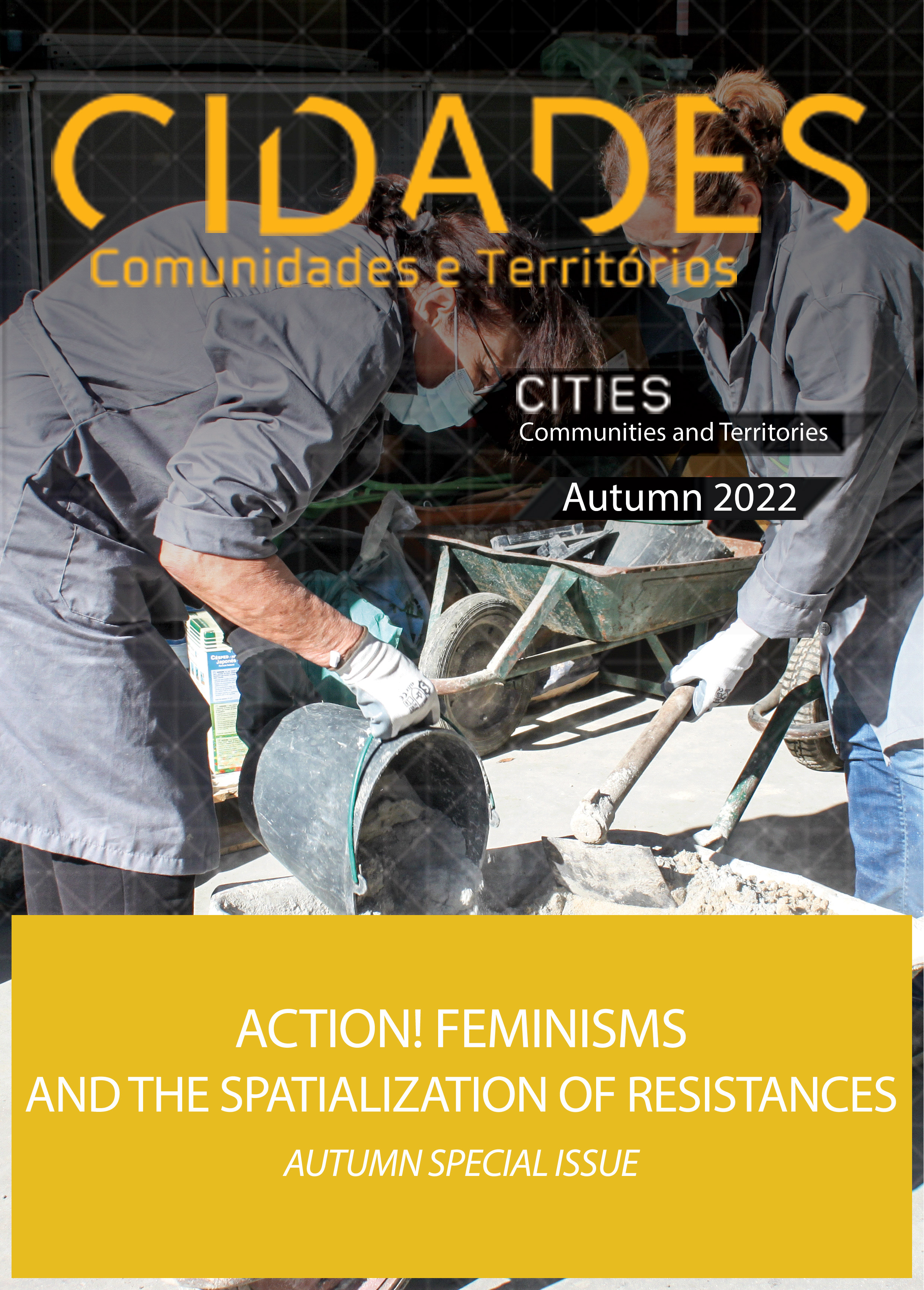Encarnando o vírus: intervenções epistêmicas e performativas à hegemonia disciplinar na arquitetura e urbanismo
Palavras-chave:
arquiteturas feministas, feminismo, performatividade, hegemonia, epistemesResumo
Nossas experiências no cotidiano, no doméstico, no publico, são dados de pesquisa significativos, para novas abordagens epistemológicas, ou seja, da Arquitetura Feminista a contra o assujeitamento através de um rito normativo que busca demarcar e fixar a lógica socioeconômica sobre nossos corpos. A hegemonia na produção e reprodução do conhecimento na disciplina de arquitetura, assim como suas metodologias, têm sido disputados pelo movimento feminista, principalmente nas últimas décadas do século XX. Falamos de uma visão específica hegemônica da disciplina baseada em normas, valores e ideias, de onde se exerce o poder do material, historicamente resultando no apagamento, desapropriação e apropriação do trabalho exercido pelos corpos femininos, mas não só. Repensar a epistemologia da arquitetura, e o funcionamento dos dispositivos semióticos políticos, implica repensar a ligação vida-território-corpo-espacialidade-vínculo, ampliando os fundamentos que desenham a disciplina. Assim, propomos uma reflexão sobre como podemos esticar a arquitetura com vista a escapar às normas tradicionais sobre o entendimento do espaço, como categoria e conceito diante de uma crise potencialmente produtiva para a construção de uma Arquitetura Feminista. Uma perspectiva de formulação encarnando um vírus para uma epistemologia do cotidiano, do corpo-território, para apontamento de possibilidades de analíticas situadas em diferentes formas epistêmicas e performáticas de intervir, desafiar e contestar a hegemonia disciplinar nos estudos arquitetônicos e urbanos.
Referências
Bhattacharya, T. (Ed.) (2017). Social Reproduction Theory: Remapping Class, Recentering Oppression. London: Pluto Press.
Baydar Nalbantoglu, G. (1998). Toward postcolonial openings: rereading Sir Banister Fletcher's “History of Architecture”. Assemblage, 35, 6–17.
Butler, J. (2019). Corpos que importam. São Paulo: Crocodilo Edições.
Butler, J. (2014). Precarious Life: The Powers of Mourning and Violence. London, New York: Verso.
Carbajal, M. & Segato, R. (2010). Las mujeres nunca han sufrido tanta violencia doméstica como en la Modernidad, Página 12. https://www.pagina12.com.ar/diario/dialogos/21-139835-2010-02-08.html.
Carrillo, J. (2007). Entrevista com Beatriz Preciado. Cadernos Pagu, 28, 375–405. https://doi.org/10.1590/S0104-83332007000100016.
de Jong, A. (2020). The Multiplicity of Other. Values for survival: Cahier 1, 89–97 https://openresearch.amsterdam/en/page/56356/chapter-3-multiplicity-of-other.
Fanon, F. (1963). The Wretched of the Earth. New York: Grove Press (original em francês 1961).
Federici, S. (2021). O patriarcado do salário: Notas sobre Marx, gênero e feminismo. São Paulo: Boitempo.
Federici, S. (2017). Calibã e a bruxa: mulheres, corpo e acumulação primitiva. São Paulo: Elefante.
Foucault, M. (1988). História da sexualidade I: A vontade de saber. Rio de Janeiro, Edições Graal, 1988 (original em francês 1976).
Godinho Lima, A. G. (2012). Arquitetas e arquiteturas na América Latina do século XX. São Paulo: Altamira.
Haraway, D. (2009). Saberes localizados: a questão da ciência para o feminismo e o privilégio da perspectiva parcial. Cadernos Pagu, 5, 7–41, https://periodicos.sbu.unicamp.br/ojs/index.php/cadpagu/article/view/1773
Kristeller, P. O. (1944-1945). Humanism and Scholasticism in the Italian Renaissance, Byzantion, 17, 346–374.
Lefebvre, H. (2000). La production de l’espace. Paris: Anthropos
Lerner, G. (1986). The Creation of Patriarchy. New York, London: Oxford University Press.
Lorey, I. (2012). Estado de inseguridad. Gobernar la precariedad. Madrid: Traficantes de Sueños.
Moisset, I. et al. (2015). Un día/una arquitecta. https://undiaunaarquitecta.wordpress.com/indice/indice-cronologico/
Molyneux, M. (2010) Mobilization Without Emancipation? Women's interests, the state, and revolution in Nicaragua. In M. N. Krook, & S. Childs (Eds.), Women, gender, and politics: a reader (pp.21–28). Oxford: Oxford University Press.
Muxí Martínez, Z. (2018). Mujeres, casas y ciudades: más allá del umbral. Barcelona: dpr-barcelona.
Nevejan, C. (2020). Multiplicity of Other 3. Values for Survival: Cahier 1, 85–120 https://openresearch.amsterdam/en/page/56356/chapter-3-multiplicity-of-other.
Novas Ferradás, M. (2021). Arquitectura y género. Una introducción posible. Santa Cruz de Tenerife: Melusina.
Ribeiro, A. C. T. (2010). Dança dos sentidos: na busca de alguns gestos. In P. B. Jacques & F. D. Britto (Eds.), Corpocidade: debates, ações e articulações (pp. 24–41). Salvador: EDUFBA.
Rose, G. (1993). Feminist & Geography: The limits of geographical knowledge. Cambridge, Oxford: Polity Press.
Ruiz Menéndez, O. (2021). ¿Qué pasa con la casa? (y las violencias contra mujeres y niñas)? Píkara Magazine, https://www.pikaramagazine.com/2021/06/que-pasa-con-la-casa-y-las-violencias-contra-mujeres-y-ninas/.
Said, E. W. (1983). The World, the Text and the Critic. Cambridge, Massachusetts: Harvard University Press Cambridge.
Salem, S. (2020). Gramsci in the Postcolony: Hegemony and Anticolonialism in Nasserist Egypt. Theory, Culture and Society, 21, https://doi.org/10.1177/0263276420935178.
Sanchez Llorens, M., Feliz Ricoy, S., Amann y Alcocer, A., & Martella, F. (2021). Cuidados. Actas Primer Congreso Internacional Feminista Sobre Arquitectura y Cuidados. Madrid: Universidad Politécnica de Madrid. https://issuu.com/congresoarquitecturaycuidados/docs/actas_congreso_arquitectura_y_cuidados.
Segato, R. L. (2003). Las Estructuras Elementales de la Violencia. Buenos Aires: Prometeo.
Segato, R. L. (2013). La escritura en el cuerpo de las mujeres asesinadas en Ciudad Juárez. Territorio, soberanía y crímenes de segundo estado. Buenos Aires: Tinta Limón.
Soihet, R. (1989). Condição feminina e formas de violência: mulheres pobres e ordem urbana, 1890-1920. Rio de Janeiro: Forense Universitária.
Sontag, S. (1977). Illnes as Metaphor. New York: Farrar, Straus and Giroux.
Spivak, G. C. (2002). ¿Puede hablar la subalterna? Asparkía: Investigació Feminista, 13, 207–214, https://doi.org/10.6035/Asparkia.
Tavares, R. B., & Ramos, D. H. . (2021). Indisciplina Epistemológica: Viradas metodológicas para o campo da Arquitetura e Urbanismo. Indisciplinar, 7(2), 232–277. https://periodicos.ufmg.br/index.php/indisciplinar/article/view/38147.
Tavares, R. B. & Bonadio, M. G. (2021). Ao encontro do corpo: teorias da performatividade para um debate diferencial sobre espaço urbano. Revista Brasileira de Estudos Urbanos e Regionais, 23, https://doi.org/10.22296/2317-1529.rbeur.202115.
Tavares, R. B. (2015). Indiferença à Diferença: espaços urbanos de resistência na perspectiva das desigualdades de gênero [Tese de doutorado. Programa de Pós-graduação em Urbanismo, UFRJ].
Downloads
Publicado
Edição
Secção
Licença
Direitos de Autor (c) 2022 Rossana Brandao Tavares, María Novas, Laura Sarmiento

Este trabalho encontra-se publicado com a Licença Internacional Creative Commons Atribuição-NãoComercial-SemDerivações 4.0.
Cidades, Comunidades e Territórios by DINÂMIA'CET-IUL is licensed under a Creative Commons Atribuição-Uso Não-Comercial-Proibição de realização de Obras Derivadas 4.0 Unported License.Permissions beyond the scope of this license may be available at mailto:cidades.dinamiacet@iscte.pt.







